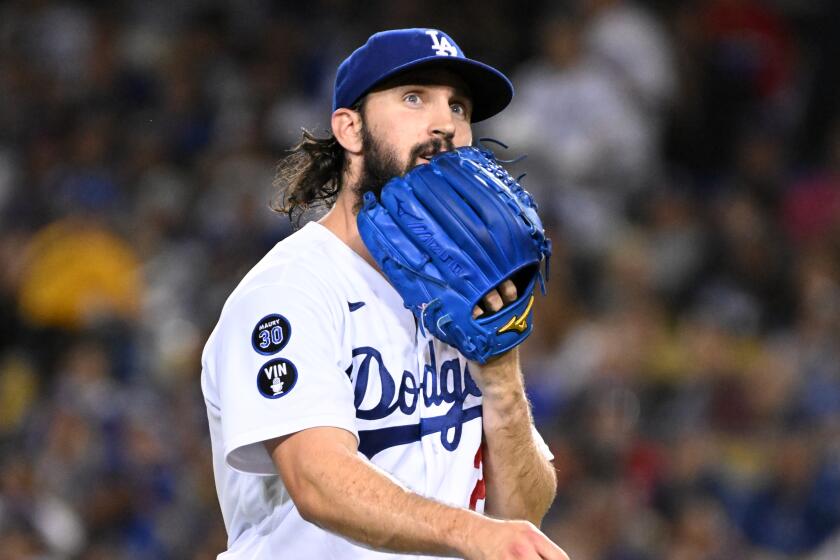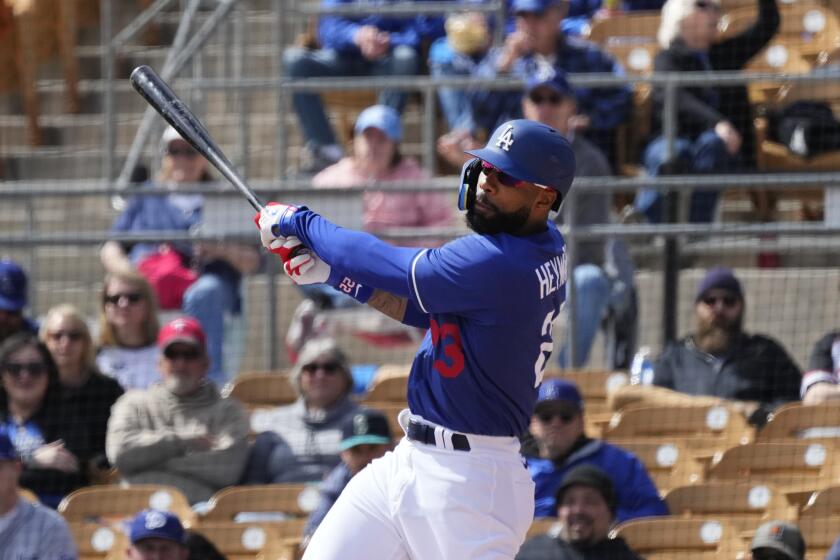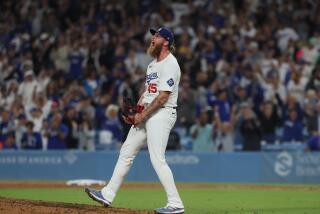Brusdar Graterol has the ‘best stuff on the planet.’ So why isn’t he a closer yet?
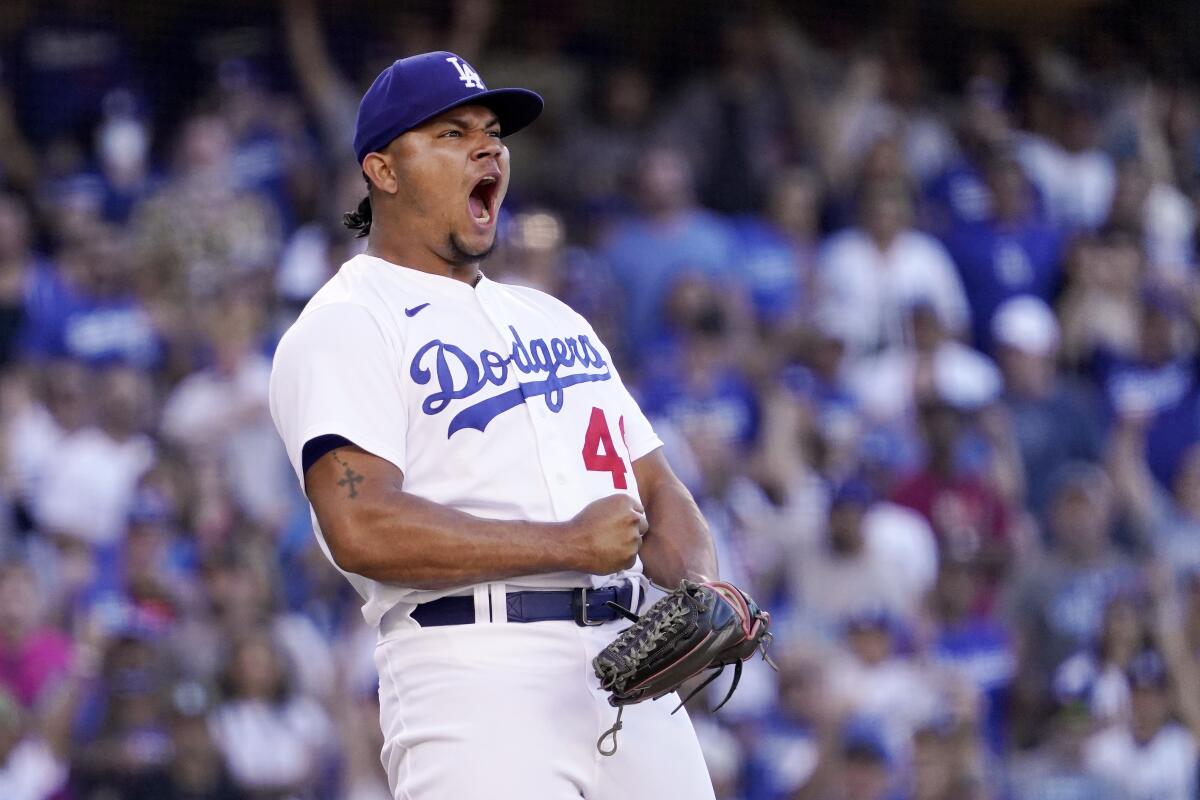
- Share via
PHOENIX — The combination of nitro-fueled fastball and nickname doesn’t merely suggest that Dodgers reliever Brusdar Graterol has the makings of a big league closer. It screams it.
The burly right-hander has a nasty two-seam sinking fastball that averaged 99.8 mph with 20 inches of drop and 15 inches of left-to-right break last season and a four-seamer that averaged 99.4 mph and touched 102.5 mph.
“He’s got the best stuff on the planet,” Dodgers reliever Alex Vesia said.
And a moniker to match. Graterol’s Minnesota Twins teammates dubbed him “Bazooka” when he broke into the majors in 2019 because the ball seems to explode out of his hand as if shot from a rocket launcher.
A freak ankle injury is likely to keep Tony Gonsolin out of the Dodgers’ rotation for a couple of starts at the beginning of the season.
“I think it’s the perfect nickname for me,” Graterol said.
But until Graterol can get left-handed hitters out with more consistency, develop a more effective slider to keep hitters off his fastball and avoid the nagging injuries that derailed him the last two seasons, he will not be called “closer.”
Graterol has held right-handed hitters to a .202 batting average, .512 on-base-plus-slugging percentage and two homers in 292 plate appearances over four big league seasons, but left-handers have hit .294 with an .847 OPS and five homers in 183 plate appearances against him.
The 24-year-old Venezuelan threw a cut-fastball — mostly to left-handers — that averaged 95.6 mph with a 22-inch drop but virtually no horizontal break last season, which is why batters hit .302 (13 for 43) on the cutters they put in play.
“He certainly has the mindset and the stuff to close, but there’s a neutrality to being a dedicated closer,” manager Dave Roberts said, alluding to the need for ninth-inning specialists to be effective against both left-handers and right-handers. “We’re continuing to work on making him more of a neutral pitcher.”
The Dodgers will open the season without a designated closer. Right-hander Evan Phillips, their most effective and durable reliever last season, will pitch in the most important situations. Daniel Hudson will also be a vital part of the group, but he isn’t likely to be ready for the start of the season because of lingering knee and ankle injuries.
Graterol and the left-handed Vesia and Caleb Ferguson will pitch in high-leverage situations, but Graterol could also seize a ninth-inning role.
“Yeah, it’s right there in front of him, so go ahead and take it,” assistant pitching coach Connor McGuiness said. “His ceiling is as high as he wants it to go. He’s a very hard worker. He’s one of the best athletes I’ve ever seen. He fields so well he could win a Gold Glove. For him, it’s just a matter of going out and executing.”
Graterol notched the first four saves of his career last season. Roberts wouldn’t rule out the possibility of Graterol closing, but the manager often prefers to use him against a run of tough right-handed hitters regardless of the inning.
“The bottom line is I trust Brusdar in any situation,” Roberts said. “You could argue that some of the spots I’ve put him in are more leverage than a three-run save situation in the ninth. People get caught up a lot in a role and feel that’s their value. That’s something as a coach that I have to navigate and understand.”
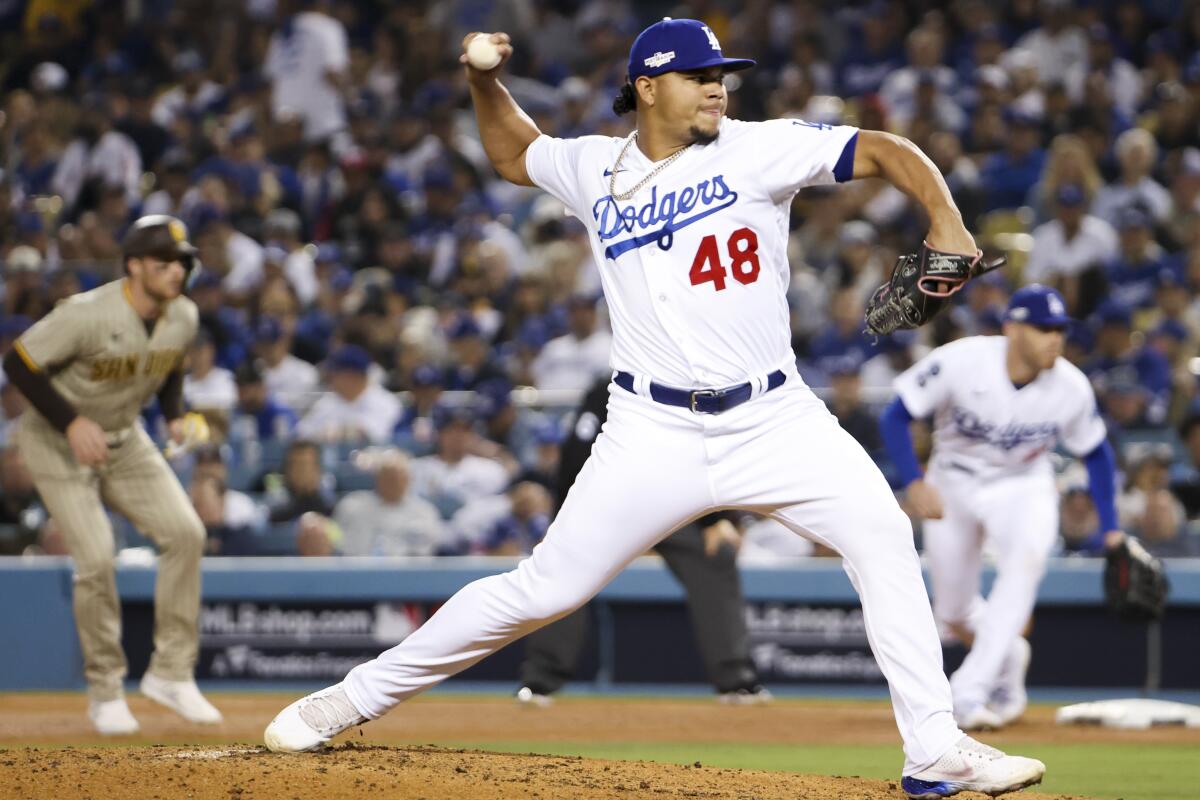
The 6-foot-1, 262-pound Graterol has looked sharp this spring, giving up five hits, striking out four and walking none in five innings of five games, including Saturday’s scoreless inning against the Chicago White Sox in which his slider had better depth.
The slider averaged 90.6 mph with a 30-inch drop and seven-inch, right-to-left break last season, and Graterol held opponents to a .158 batting average (six for 38) in at-bats ending with the pitch. But Roberts believes a better slider will improve Graterol’s modest strikeout rate of 7.2 whiffs per nine innings.
“He’s been searching to find the right shape of that breaking ball,” Roberts said. “Hopefully he can find something he likes and can be consistent with because the fastball command is elite. Hopefully he can find something he can trust to go to in a big spot, that gives him the velocity differential we’re looking for.
“When he’s on the mound, everything’s hard. If you have something to slow the hitters down a bit, to get them off the fastball and cutter, it creates more upside.”
For all the tinkering and fine-tuning this spring, Graterol has one goal entering the season: “To stay healthy all year,” he said. He did not in 2021 and 2022.
Graterol, acquired from Minnesota for starter Kenta Maeda in February 2020, avoided injury in his first season in Los Angeles, going 1-2 with a 3.09 ERA in 23 games of the pandemic-shortened 2020 season and yielding three earned runs in 7⅔ innings in nine playoff games to help the Dodgers win the World Series.
He went 3-0 with a 4.59 ERA in 34 games in 2021, losing three weeks of April to COVID-19, all of May to right forearm tightness and all of June to a demotion to triple A for what Roberts called, at the time, “finishing school.”
Graterol found his bearings by October and pitched in eight of 12 postseason games in 2021, giving up one run and four hits, striking out seven and walking none in nine innings.
He went 2-4 with a 3.26 ERA and four saves in 46 games in 2022, striking out 43 and walking 10 in 49⅔ innings, but he missed two months because of shoulder and elbow injuries.
His ceiling is as high as he wants it to go. He’s a very hard worker. He’s one of the best athletes I’ve ever seen. He fields so well he could win a Gold Glove.
— Connor McGuiness, Dodgers assistant pitching coach, on Brusdar Graterol
There has been some speculation that because Graterol has a shorter stride and generates much of his torque with his upper body, he is putting more stress on his shoulder and elbow. But the Dodgers have no plans to change his mechanics.
“It’s hard to say that a mechanical change is going to prevent injuries any time a guy is throwing 100 mph,” McGuiness said. “I think you run down a slippery slope trying to change someone’s stride length or anything like that, especially given his throw.”
Graterol didn’t believe his weight was an issue, but modifications to his winter training regimen — he worked out three times a day most days, with more stretching and cardio — and his diet helped him trim down from 285 pounds to 262.
“My weight was up, but my velo was there — I was throwing 102-103 mph,” Graterol said. “But I do feel much better. I feel like I can do everything easier.”
Teammates noticed the weight loss immediately. “I saw him the first day of spring training,” Vesia said, “and I said, ‘You came ready to go this year.’ ” Roberts said the weight loss didn’t necessarily show an increased commitment. “I would say it shows his maturity,” Roberts said.
McGuiness isn’t sure whether or how Graterol will benefit from being lighter.
“It can help him potentially build up a proper foundation to withstand the full season and help him kind of recover a little better,” McGuiness said. “But there is an argument that being a little heavier coming into the year can be beneficial as well. So there are two sides of that coin.”
Jason Heyward has cooled down since a hot start at the plate in spring training but Dave Roberts remains encouraged by the veteran outfielder.
The Dodgers had an established closer for a decade when Kenley Jansen held the role from 2012 to 2021, and they entered 2022 with veteran closer Craig Kimbrel as their ninth-inning specialist.
Late-game pitching decisions will be based more on matchups than defined roles this season, but whether he is a closer, setup man or short reliever, Graterol will be an important part of the mix.
“Doc’s gonna keep putting him in there in big situations, and we’ll need him to be healthy the whole year,” Vesia said of Graterol. “He’s gonna be a huge part of our bullpen, whether it’s in the seventh or eighth or ninth inning.”
More to Read
Are you a true-blue fan?
Get our Dodgers Dugout newsletter for insights, news and much more.
You may occasionally receive promotional content from the Los Angeles Times.

